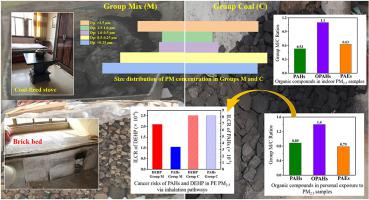当前位置:
X-MOL 学术
›
Atmos. Res.
›
论文详情
Our official English website, www.x-mol.net, welcomes your feedback! (Note: you will need to create a separate account there.)
Characteristics of indoor and personal exposure to particulate organic compounds emitted from domestic solid fuel combustion in rural areas of northwest China
Atmospheric Research ( IF 5.5 ) Pub Date : 2021-01-01 , DOI: 10.1016/j.atmosres.2020.105181 Kailai He , Hongmei Xu , Rong Feng , Zhenxing Shen , Yaqi Li , Yue Zhang , Jian Sun , Qian Zhang , Tian Zhang , Liu Yang , Pingping Liu , Kin Fai Ho , Junji Cao
Atmospheric Research ( IF 5.5 ) Pub Date : 2021-01-01 , DOI: 10.1016/j.atmosres.2020.105181 Kailai He , Hongmei Xu , Rong Feng , Zhenxing Shen , Yaqi Li , Yue Zhang , Jian Sun , Qian Zhang , Tian Zhang , Liu Yang , Pingping Liu , Kin Fai Ho , Junji Cao

|
Abstract Household solid fuel combustion for heating in winter is a substantial source of air pollution in rural areas of northwest China. The present study investigated the concentration characteristics and health risks of particulate matter (PM) and its organic compounds, including polycyclic aromatic hydrocarbons (PAHs), oxygenated PAHs (OPAHs), and phthalate esters (PAEs). Indoor air and housewives' personal exposure (PE) samples were collected in Guanzhong Basin, among rural households relying on various solid fuels for heating in winter. Indoor PM primarily comprised fine PM (PM2.5, 76%), and its organic compounds were identified in particular abundance in households that used coal as the only domestic fuel (Group C, 96% in PM2.5). The mean concentration of PE to PM2.5 was 307 ± 120 μg·m−3, which was 2.4-times higher than the indoor concentration (130 ± 103 μg·m−3) because of the housewives' short-term exposure to high-concentration pollution emitted by solid fuel combustion. Organic compounds exhibited the same pattern, with PE samples having a 44% higher concentration than indoor samples. The correlation of PM2.5-bound organics between indoor and PE samples in Group C (R2 = 0.9) was higher than that in the group using coal and biomass (Group M, R2 = 0.6), indicating the stronger correlation of single-fuel heating method. The PE/indoor ratio of high molecular weight (HMW) PAHs in Group C (2.5) was higher than that of the other organic compounds (1.3) because HMW PAHs emitted through coal combustion had a larger effect on PE. This further led to higher incremental lifetime cancer risks (ICLRs) via inhalation pathway among housewives in Group C (2.4- and 1.2-times higher risk for PAHs and PAEs, respectively) than among those in Group M. However, inhalational ILCR values of Group M were still 2.1–340-times higher than the international safety standard (10−6). Therefore, the upgradation of domestic fuels and heating ways is urgently needed in rural area of northwest China to reduce indoor air pollution and health risks.
更新日期:2021-01-01



























 京公网安备 11010802027423号
京公网安备 11010802027423号